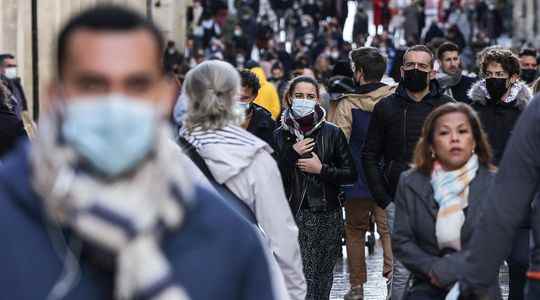The National Academy of Medicine, the committee for monitoring and anticipating health risks (Covars) or even general practitioners and pharmacists… Voices are multiplying to encourage the return of the mask in closed places and public transport to the approach of winter. If the epidemiological data are rather stable and do not reflect, for the time being, a growing concern, the combined arrival of influenza and gastroenteritis, from which society has been rather spared for two years with the generalization of barrier gestures , led the Academy of Medicine to again consider it “necessary” to wear a mask.
However, in the streets, the mask is rather rare on the faces. The latest CoviPrev survey from Public Health France, published in early October, confirmed this feeling of relaxation. Only 16% of respondents said they systematically wear the protective fabric. This rate reached 71% in January and 34% last May. “At the start of the pandemic, very few French people were opposed to the generalized obligation to wear a mask. Two and a half years later, there is a form of strategic behavior on the part of the French which consists in wearing a mask according to the waves which cross society”, comments to L’Express Jocelyn Raude, teacher-researcher in social psychology at the School of Advanced Studies in Public Health (EHESP) in Rennes and specialist in collective behavior.
Since the gradual lifting of obligations in various public places, the mask has been abandoned. More than 60% of respondents even claim to leave it at the bottom of their backpack when they take public transport. Will the opinion of Covars (successor of the Scientific Council), which considers that “communication on the wearing of masks” must “be reinforced (…) and repeated”, be heard? Nothing is less certain in the eyes of Thierry Le Breton, professor of sociology at the University of Bordeaux and author of the book Faces, an anthropology (Métailié editions). “As the threat is not perceived by the population as serious due to a form of normalization of the epidemic situation, there is a reluctance to wear the mask again,” he explains.
Risk-benefit balance
The epidemic is currently experiencing its eighth wave. Compared to the first, intensive care admissions have decreased and serious forms have been shown to be less frequent. These indicators should not, however, make us forget the health reality, which remains marked by an increased circulation of Covid-19, and the vulnerability of the most vulnerable to the disease. A form of habituation has thus been generated in society, point out the two researchers. “The idea that we can relax our efforts because the big threats are behind us is diffuse,” notes Thierry Le Breton. Faced with the inconvenience caused by the daily wearing of a mask, the benefit-risk balance leans towards the option of removing it. The pimples on the skin linked to repeated contact with the mask, the difficulties of social interactions or the fogging of the glasses would weigh more heavily than contamination deemed distant.
For many, the pandemic would thus become an abstract issue, a meaningless statistic rather than a concrete threat to their health. This feeling would be reinforced by the emergence of other crises. The war in Ukraine and the threat of a nuclear confrontation have long been at the heart of Spring’s concerns. The energy crisis and galloping inflation have given some households the challenges they thought were behind them, such as paying their heating bills, for example. “The epidemic is falling in the hierarchy of considerations of the French”, estimates Thierry Le Breton. His colleague, Jocelyn Raude, confirms: “There has been a trivialization of the effects of Covid-19.”
Splitting and individualization
This is especially true in a segment of society: those who feel immune. They are young, vaccinated, without comorbidity and struggle to see the risk to their health of contracting the virus. Adherence to wearing a mask, for them, materializes especially when they have experienced supporting a loved one suffering from the coronavirus. “It brings the threat closer to the eyes,” says sociology professor Thierry Le Breton. On the other side of the spectrum, we observe a population worried by the circulation of the coronavirus which multiplies the precautions. These are the elderly, overweight or multiplying risk factors. “There is a form of individualization of the wearing of the mask with targets that react differently to the waves”, he summarizes.
What push the public authorities to redefine the contours of the policy of containing the spread of the virus? This seems obvious to Jocelyn Raude, who advocates for an individualized approach. “There are people who are more apt to wear the mask because they are elderly, risk carriers or because they rub shoulders with people at risk. Communication around prevention must be more oriented towards these targets. It is a question of protecting more fragile people. At the same time, we must get out of the tenacious belief that what is recommended is not important and what is mandatory is. Let’s give more strength to the recommendations.”
